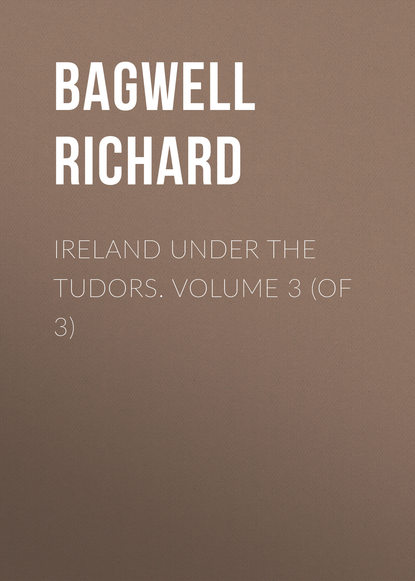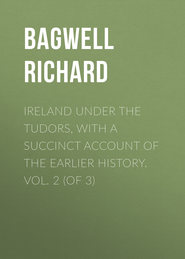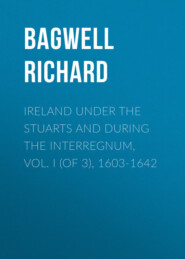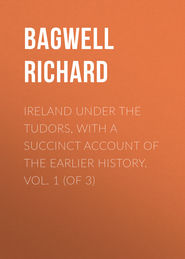По всем вопросам обращайтесь на: info@litportal.ru
(©) 2003-2024.
✖
Ireland under the Tudors. Volume 3 (of 3)
Настройки чтения
Размер шрифта
Высота строк
Поля
123
Perrott to Privy Council, Sept. 15 and 17.
124
Norris to Burghley, Oct. 16, 1584. The various agreements are in Carew, from Sept. 18 to Oct. 7. Perrott returned to Dublin within a few days of the latter date. On the 20th he sent Walsingham ‘Holy Columkill’s cross, a god of great veneration with Sorley Boy and all Ulster… When you have made some sacrifice to him, according to the disposition you bear to idolatry, you may, if you please, bestow him upon my good Lady Walsingham or my Lady Sidney, to wear as a jewel of weight and bigness, and not of price and goodness, upon some solemn feast or triumph day at the Court.’
125
Norris to Burghley, Oct. 16, 1584. See also (in Russell and Prendergast’s Calendar) Sir John Davies to Salisbury, July 1, 1607, and Aug. 5, 1608, and the second conference about the Plantation, Jan. 12, 1610; and J. C. Beresford’s report in the Concise View of the Irish Society, p. ccxxii. In the Irish Archæological Journal, vol. i. p. 477, Ormonde’s contemporary panegyrist, who is an unconscious satirist, says:
Twice he set Glenconkein on fire,
This wealthy and tender-hearted chieftain;
He left no herds around Lough Neagh,
This seer so provident and bountiful.
According to O’Donovan (Four Masters, 1526) Glenconkein originally composed the parishes of Ballinascreen, Desertmartin, and Kilcronaghan.
126
Sir J. Cusack to Cecil, Feb. 2, 1564; Memorial for Perrott in Desiderata Curiosa Hibernica; Fenton to Burghley, Jan. 31, 1584; Petition to the Judges, Feb. 16; Perrott to Walsingham, Aug. 21; and to Burghley, Oct. 22.
127
Loftus to Walsingham, Oct. 4, 1584; and March 21, 1585; to Burghley, March 18, 1585; Petition of the prebendaries (with enclosures), Dec. 1584. See also Ware’s Bishops, arts. ‘Jones’ and ‘Loftus,’ and Cotton’s Fasti. Writing to Burghley, Jan 10, 1585, Loftus says the only great abuse was the non-residence of prebendaries, some of them by her Majesty’s express command, and he proposes to remedy this by calling on them to reside, or resign. Bancroft was one of these privileged absentees. For Swift’s remark see Monck Mason’s Hist. of St. Patrick’s, book ii. chap. iii. sec. 8, where another disgraceful lease made by Jones is also mentioned. Loftus was an accomplice in this later case.
128
Burghley to Perrott, Nov. 6, 1584; Loftus to Burghley, June 7 and 11, 1585. Writing to Burghley on the previous 10th of Jan., Loftus says Fenton had dealt earnestly for the overthrow of St. Patrick’s. ‘After all,’ says Monck Mason, ‘the opposition made by Loftus must be considered as quite reasonable. Had the scheme taken effect there would scarcely have remained a single benefice in the gift of the Archbishop; the Crown presented to all the dignities in the other cathedral, and the Chapter to all the prebends.’ —Hist. of St. Patrick’s, book i. ch. 14.
129
Stanley to Walsingham, Sept. 17, 1584; Norris to Burghley, Nov. 20; Sir N. White to Perrott, Sept. 16; Bingham to Walsingham, Nov. 24 and Dec. 21; and to Burghley, Dec. 24; Perrott to Burghley, Dec. 4.
130
Perrott to the Privy Council, Oct. 25, 1584; to Walsingham (enclosing that to the High Court of Parliament), Jan. 17, 1585; to the Queen, April 1; Walsingham to Perrott, Feb. 1; the Queen to Perrott, April 14. Perrott’s proposed towns were Athlone, Coleraine, Sligo, Mayo, Dingle, Lifford, and Newry; bridges at Coleraine, Lifford, Ballyshannon, Dundalk, the Munster Black Water, the Feale, and Kells in Clandeboye; castles at Ballyshannon, Meelick, Castle Martin in the Route, at Gallen in King’s County, Kilcommon in Wicklow, and on both the Blackwaters.
131
Perrott to Walsingham, Nov. 16 and 27, 1584 (with enclosures); to Burghley (with enclosures), Jan. 15, 1585. – Gregory’s Western Highlands, chap. iv., where Perrott’s siege of Dunluce, and other matters belonging to 1584, are placed under 1585.
132
Stanley to Walsingham, Jan. 5, 1585; George Peverley, victualler, to Walsingham, Jan. 5; to Burghley, Jan. 20; Perrott to Walsingham, Nov. 16, 1584; to Burghley, Jan 15, 1585. The Master of the Ordnance was the same Jacques Wingfield who so narrowly escaped professional ruin in 1561.
133
Composition of Lord Deputy and Council with Sorley Boy, Oct. 17, 1575; Sorley Boy to Perrott and to Captain Carleile, Feb. 5, 1585; Captain Barkley to Perrott, Feb. 26; Norris to the Privy Council and Fenton to Walsingham, March 7; Beverley to Burghley, April 1; Perrott to Walsingham, April 24.
134
Lists printed from the roll in Tracts relating to Ireland, vol. ii. p. 134. Kildare, who died in England this year, no doubt had his writ of summons, but does not seem to have attended. He was ill in London on Aug. 3.
135
Lists as above.
136
Lists as above. Perrott’s Life, p. 199; see also a partial list of members calendared at May 11, 1586. The Four Masters, under 1585, give a sort of Homeric catalogue of the chiefs present.
137
Tracts relating to Ireland, vol. ii. p. 143. Ormonde to Burghley, Oct. 20, 1583; Sir N. White to Burghley, May 27, 1585.
138
Sir N. White to Burghley, May 27, 1585; Perrott to Walsingham, May 30; the Poyning’s Suspension Bill is in Carew, June 1585, No. 578.
139
Perrott to Walsingham, May 30 and June 18, 1585. He believed that the opposition would collapse if firmly handled, and that firmness would save the Queen’s pocket. ‘If they escape,’ he said, ‘farewell to my reputation both with Irish and English.’
140
Irish Statutes, 27 Eliz.; Perrott’s Life.
141
Norris to Walsingham, March 3; Fenton to Walsingham, May 24; Loftus to Burghley, May 31. ‘I am forced to play at small game to set the beasts here a-madding, merely for want of better game… You think, as I ought to think, that it is time for me to have done with the world; and so I would, if I could get into a better, before I was called into the best, and not die here in a rage, like a poisoned rat in a hole.’ – Swift to Bolingbroke, from Dublin, March 21, 1729.
142
Perrott’s Life; James VI. to Perrott, Aug. 8, in Carew; Perrott to Walsingham, Aug. 10 and Nov. 11; to Burghley, Sept. 8 and 24; Sir H. Bagenal to Perrott, Sept. 3; Wallop to Burghley and Walsingham, Nov. 18; Walsingham to Archbishop Long, Dec.
143
Composition Book of Connaught and Thomond, Oct. 3. Details may be studied in the appendix to Hardiman’s edition of O’Flaherty’s West Connaught. As to the measurement it may be observed that Clare, to take one county as an example, is estimated at 1,260 quarters. Making allowance for the difference between Irish and English measure, this gives rather less than 250,000 statute acres for all Clare. The real area is about 828,000 acres. The gross acreage of all Connaught and Clare is about five millions and a quarter, and a rental of 4,000l. gives much less than a farthing per acre.
144
Perrott to Burghley, Sept. 8 and 24, 1585. The ‘Articles’ referred to were sent to Ireland by Fenton in the following spring, and are printed in Desiderata Curiosa Hibernica, i. 63.
145
Perrott to Walsingham, Jan. 27, 1586; Sir G. Carew to Walsingham Feb. 27; to Burghley, Aug. 2, 1588, in Carew; Lord Deputy and Council to the Privy Council, Jan. 28, 1586; description of Munster, 1588, p. 530; Wallop to Burghley, Oct. 1585 (No. 19) and Nov. 18; to Walsingham, March 7, 1586; Vice-President Norris to the Privy Council, Oct. 18, 1586.
146
Perrott to Privy Council, Sept. 15 and 17.
124
Norris to Burghley, Oct. 16, 1584. The various agreements are in Carew, from Sept. 18 to Oct. 7. Perrott returned to Dublin within a few days of the latter date. On the 20th he sent Walsingham ‘Holy Columkill’s cross, a god of great veneration with Sorley Boy and all Ulster… When you have made some sacrifice to him, according to the disposition you bear to idolatry, you may, if you please, bestow him upon my good Lady Walsingham or my Lady Sidney, to wear as a jewel of weight and bigness, and not of price and goodness, upon some solemn feast or triumph day at the Court.’
125
Norris to Burghley, Oct. 16, 1584. See also (in Russell and Prendergast’s Calendar) Sir John Davies to Salisbury, July 1, 1607, and Aug. 5, 1608, and the second conference about the Plantation, Jan. 12, 1610; and J. C. Beresford’s report in the Concise View of the Irish Society, p. ccxxii. In the Irish Archæological Journal, vol. i. p. 477, Ormonde’s contemporary panegyrist, who is an unconscious satirist, says:
Twice he set Glenconkein on fire,
This wealthy and tender-hearted chieftain;
He left no herds around Lough Neagh,
This seer so provident and bountiful.
According to O’Donovan (Four Masters, 1526) Glenconkein originally composed the parishes of Ballinascreen, Desertmartin, and Kilcronaghan.
126
Sir J. Cusack to Cecil, Feb. 2, 1564; Memorial for Perrott in Desiderata Curiosa Hibernica; Fenton to Burghley, Jan. 31, 1584; Petition to the Judges, Feb. 16; Perrott to Walsingham, Aug. 21; and to Burghley, Oct. 22.
127
Loftus to Walsingham, Oct. 4, 1584; and March 21, 1585; to Burghley, March 18, 1585; Petition of the prebendaries (with enclosures), Dec. 1584. See also Ware’s Bishops, arts. ‘Jones’ and ‘Loftus,’ and Cotton’s Fasti. Writing to Burghley, Jan 10, 1585, Loftus says the only great abuse was the non-residence of prebendaries, some of them by her Majesty’s express command, and he proposes to remedy this by calling on them to reside, or resign. Bancroft was one of these privileged absentees. For Swift’s remark see Monck Mason’s Hist. of St. Patrick’s, book ii. chap. iii. sec. 8, where another disgraceful lease made by Jones is also mentioned. Loftus was an accomplice in this later case.
128
Burghley to Perrott, Nov. 6, 1584; Loftus to Burghley, June 7 and 11, 1585. Writing to Burghley on the previous 10th of Jan., Loftus says Fenton had dealt earnestly for the overthrow of St. Patrick’s. ‘After all,’ says Monck Mason, ‘the opposition made by Loftus must be considered as quite reasonable. Had the scheme taken effect there would scarcely have remained a single benefice in the gift of the Archbishop; the Crown presented to all the dignities in the other cathedral, and the Chapter to all the prebends.’ —Hist. of St. Patrick’s, book i. ch. 14.
129
Stanley to Walsingham, Sept. 17, 1584; Norris to Burghley, Nov. 20; Sir N. White to Perrott, Sept. 16; Bingham to Walsingham, Nov. 24 and Dec. 21; and to Burghley, Dec. 24; Perrott to Burghley, Dec. 4.
130
Perrott to the Privy Council, Oct. 25, 1584; to Walsingham (enclosing that to the High Court of Parliament), Jan. 17, 1585; to the Queen, April 1; Walsingham to Perrott, Feb. 1; the Queen to Perrott, April 14. Perrott’s proposed towns were Athlone, Coleraine, Sligo, Mayo, Dingle, Lifford, and Newry; bridges at Coleraine, Lifford, Ballyshannon, Dundalk, the Munster Black Water, the Feale, and Kells in Clandeboye; castles at Ballyshannon, Meelick, Castle Martin in the Route, at Gallen in King’s County, Kilcommon in Wicklow, and on both the Blackwaters.
131
Perrott to Walsingham, Nov. 16 and 27, 1584 (with enclosures); to Burghley (with enclosures), Jan. 15, 1585. – Gregory’s Western Highlands, chap. iv., where Perrott’s siege of Dunluce, and other matters belonging to 1584, are placed under 1585.
132
Stanley to Walsingham, Jan. 5, 1585; George Peverley, victualler, to Walsingham, Jan. 5; to Burghley, Jan. 20; Perrott to Walsingham, Nov. 16, 1584; to Burghley, Jan 15, 1585. The Master of the Ordnance was the same Jacques Wingfield who so narrowly escaped professional ruin in 1561.
133
Composition of Lord Deputy and Council with Sorley Boy, Oct. 17, 1575; Sorley Boy to Perrott and to Captain Carleile, Feb. 5, 1585; Captain Barkley to Perrott, Feb. 26; Norris to the Privy Council and Fenton to Walsingham, March 7; Beverley to Burghley, April 1; Perrott to Walsingham, April 24.
134
Lists printed from the roll in Tracts relating to Ireland, vol. ii. p. 134. Kildare, who died in England this year, no doubt had his writ of summons, but does not seem to have attended. He was ill in London on Aug. 3.
135
Lists as above.
136
Lists as above. Perrott’s Life, p. 199; see also a partial list of members calendared at May 11, 1586. The Four Masters, under 1585, give a sort of Homeric catalogue of the chiefs present.
137
Tracts relating to Ireland, vol. ii. p. 143. Ormonde to Burghley, Oct. 20, 1583; Sir N. White to Burghley, May 27, 1585.
138
Sir N. White to Burghley, May 27, 1585; Perrott to Walsingham, May 30; the Poyning’s Suspension Bill is in Carew, June 1585, No. 578.
139
Perrott to Walsingham, May 30 and June 18, 1585. He believed that the opposition would collapse if firmly handled, and that firmness would save the Queen’s pocket. ‘If they escape,’ he said, ‘farewell to my reputation both with Irish and English.’
140
Irish Statutes, 27 Eliz.; Perrott’s Life.
141
Norris to Walsingham, March 3; Fenton to Walsingham, May 24; Loftus to Burghley, May 31. ‘I am forced to play at small game to set the beasts here a-madding, merely for want of better game… You think, as I ought to think, that it is time for me to have done with the world; and so I would, if I could get into a better, before I was called into the best, and not die here in a rage, like a poisoned rat in a hole.’ – Swift to Bolingbroke, from Dublin, March 21, 1729.
142
Perrott’s Life; James VI. to Perrott, Aug. 8, in Carew; Perrott to Walsingham, Aug. 10 and Nov. 11; to Burghley, Sept. 8 and 24; Sir H. Bagenal to Perrott, Sept. 3; Wallop to Burghley and Walsingham, Nov. 18; Walsingham to Archbishop Long, Dec.
143
Composition Book of Connaught and Thomond, Oct. 3. Details may be studied in the appendix to Hardiman’s edition of O’Flaherty’s West Connaught. As to the measurement it may be observed that Clare, to take one county as an example, is estimated at 1,260 quarters. Making allowance for the difference between Irish and English measure, this gives rather less than 250,000 statute acres for all Clare. The real area is about 828,000 acres. The gross acreage of all Connaught and Clare is about five millions and a quarter, and a rental of 4,000l. gives much less than a farthing per acre.
144
Perrott to Burghley, Sept. 8 and 24, 1585. The ‘Articles’ referred to were sent to Ireland by Fenton in the following spring, and are printed in Desiderata Curiosa Hibernica, i. 63.
145
Perrott to Walsingham, Jan. 27, 1586; Sir G. Carew to Walsingham Feb. 27; to Burghley, Aug. 2, 1588, in Carew; Lord Deputy and Council to the Privy Council, Jan. 28, 1586; description of Munster, 1588, p. 530; Wallop to Burghley, Oct. 1585 (No. 19) and Nov. 18; to Walsingham, March 7, 1586; Vice-President Norris to the Privy Council, Oct. 18, 1586.
146








